Growth marketing framework: Battle-tested insights from Dashly experts
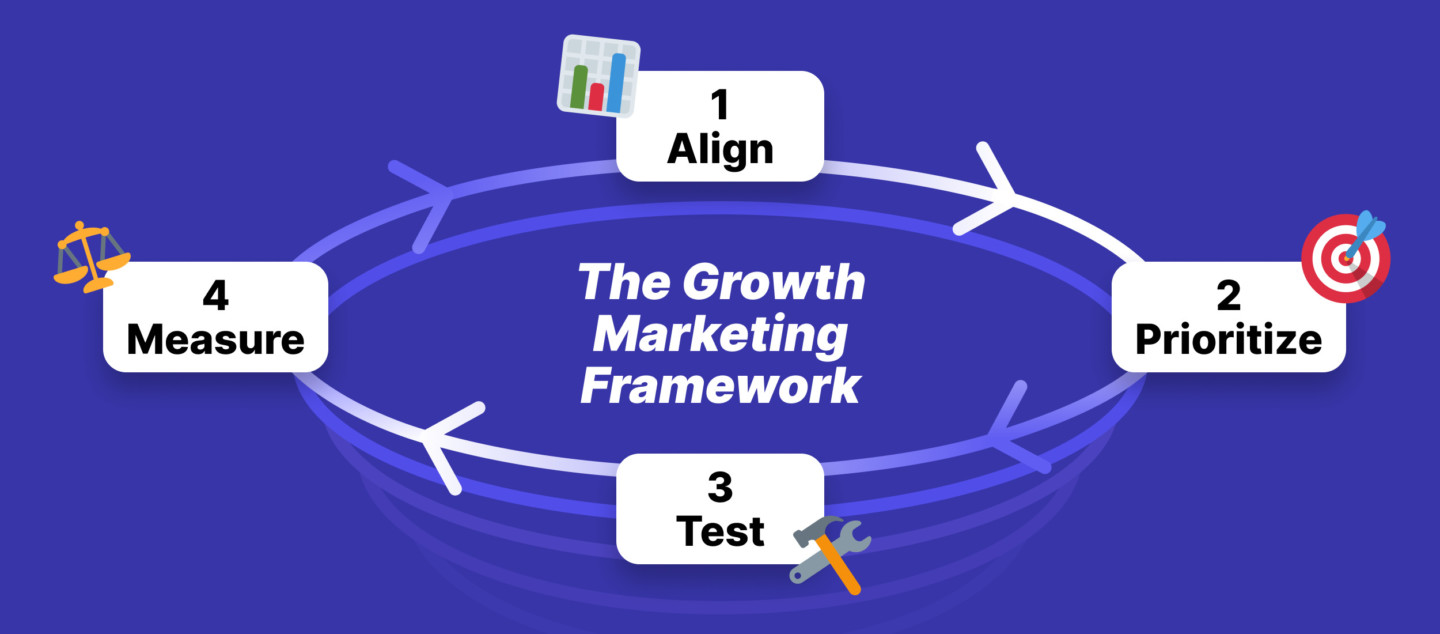
As a team of die-hard growth marketers at Dashly, we’re excited to give you a back-stage pass into our growth journey set for 2023. Our secret sauce? A mix of robust growth marketing frameworks that keep the heart of a business — the customers — at the core.
In this article, we’ll take you behind the scenes, showcasing various growth marketing frameworks and strategies we have harnessed for business elevation. You’ll get a chance to glance at our toolkit, filled with growth marketing insights straight out of our playbook.
So, whether it’s a startup, a blooming enterprise, or a seasoned giant you’re steering, there’s a wealth of knowledge to be gleaned. Let’s together sail on the captivating tide of growth marketing. Stay tuned!
What is growth marketing framework
The “growth marketing framework” is a strategic plan that focuses on driving an organization’s sustainable growth. It’s a dynamic and systematic approach that uses data, iterative testing, and customer insights to grow your product and business.
This data-driven methodology aims to acquire, retain, and engage customers effectively, optimizing their lifetime value and promoting business expansion.
Companies across various sectors utilize this framework, including tech-focused enterprises, startups, and even large-scale established businesses. Companies like Google, Amazon, Facebook, and Adobe, to name a few, have experienced significant growth and success by adopting this framework in their business model.
Example 👇
In our team at Dashly, we’ve developed a growth marketing approach that’s streamlined into four essential steps.
- Step 1: Align — This is where we select a goal, a specific growth metric that our team aims for. It’s our guiding light, our North Star.
- Step 2: Prioritize — In this step, we uncover creative solutions to reach our goals. We brainstorm, create an ideas list and then, crucially, we prioritize, considering factors like cost, resources, time, and potential growth.
- Step 3: Test — Here’s the action part — we test. And we do this iteratively. Quick deployment, speedy insights, and decisive actions define this phase.
- Step 4: Measure — After implementation comes measurement. We document test results meticulously and rely on this data to refine our strategy continuously.
Our framework is a cycle. It’s not a one-off; it’s a systematic process that drives our long-term product growth. It’s less of a destination and more of a journey of constant learning and evolution.
Thanks! Here’s your copy of 100 growth ideas
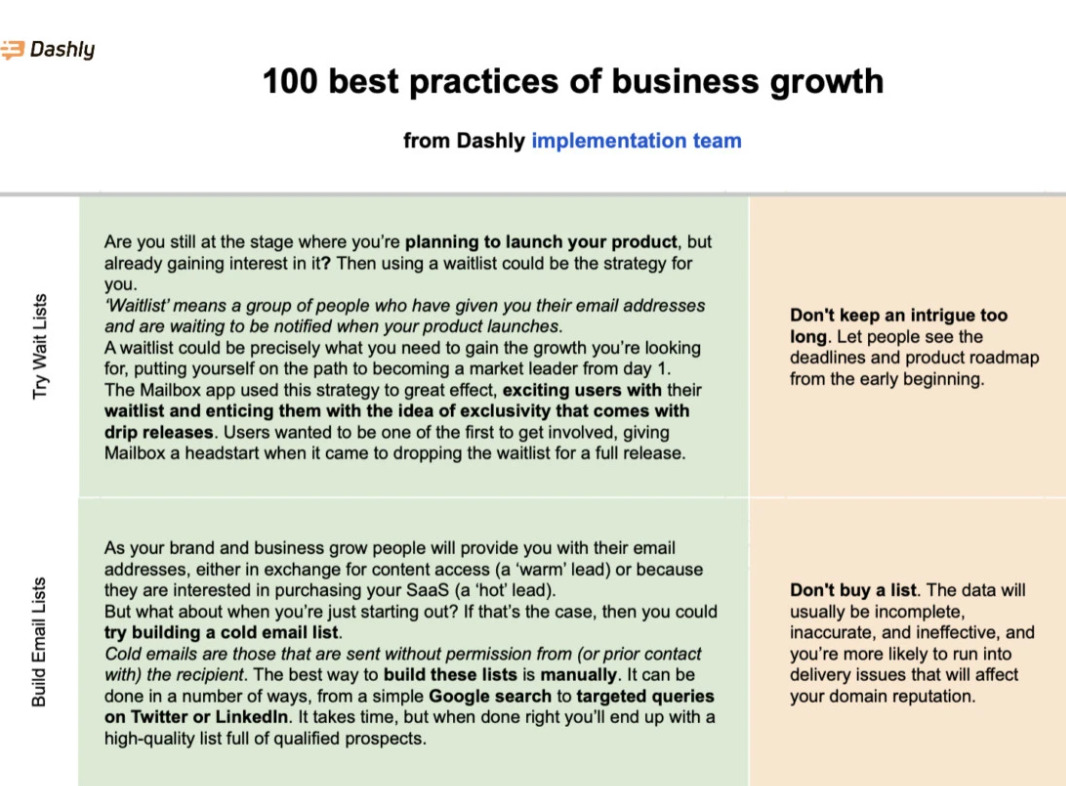
Why your business needs a growth hacking framework
Here are the top reasons why we at Dashly practice the growth marketing approach:
- Drives Sustainable Growth: A growth marketing framework helps your business achieve sustainable growth. According to a study by McKinsey & Company, businesses that prioritize growth marketing see a 20% increase in revenue.
- Customer Acquisition & Retention: Growth marketing strategies are data-driven, focusing on acquiring new customers and retaining existing ones. Companies that implement growth frameworks see up to 80% increase in customer retention according to Harvard Business Review.
- Optimized ROI: A growth marketing framework drives efficient spending by focusing on strategies with the highest return. Businesses using such a framework have seen an average ROI improvement of 30%.
- Improves Decision Making: A growth marketing framework revolves around data and insights, facilitating smarter, informed decisions. Bain & Company states that businesses leveraging data-driven frameworks are 23 times more likely to acquire customers.
- Increases Customer Lifetime Value: By focusing on customer engagement and retention, a growth marketing framework boosts the customer lifetime value (CLTV). According to Forbes, businesses using a growth framework saw an increase in CLTV by up to 75%.
Marketing framework Dashly growth team uses
In the infinite universe of growth marketing, many paths can lead your business to growth. Here at Dashly, we’ve crafted our distinct four-step growth marketing framework over many years. Its effectiveness and simplicity make it a breeze to replicate. The initial step identifies the ‘where’; the second step delves into the ‘how’; the third pinpoints the ‘what’, and the final step assesses the result, leading to a refined cycle of improvement.
Let’s decipher this further:
1. Align
Without a definitive objective, your team is like an arrow without a direction. That’s why the first avenue of our growth marketing approach revolves around settling on a target. It helps us understand what growth signifies for us as an organisation.
It may seem a little odd to narrow down to a single aim, but believe me, a well-defined goal sets up a streamlined process and aligns everyone towards the crucial priority.
Now, you might be wondering which target to go for?
Well, it’s variable.
Some marketing teams gauge success by the number of leads they pull in, but in our growth realm, we lean more towards metrics linked directly to revenue generation.
Remember, whatever yardstick your team selects, it serves as a lighthouse guiding your growth marketing pursuits — so investing time in making this decision is worth it. At Dashly, we reconvene to understand our current standing and decide upon the metrics needing accomplishment to reach our set target. It’s all about visualizing the necessary growth to accomplish our goal.
Setting the target is key: Think along the lines of, “We aim to escalate web traffic by X%” or “We’re striving to lift our traffic-to-lead conversion rate by Y%”.
2. Prioritize
Here’s where the excitement amps up in our growth marketing framework — the creative rush of conceiving strategies to hit your growth targets. Some concepts might naturally spring up during the initial stages. As you pile onto them, ponder over your business shortcomings and how those can be transformed into opportunities. Keep in mind, the most productive ideation sessions fuel unrestrained brainstorming — void of analysis, criticism, or exclusion of any ideas at this stage. Ideally, you’ll wind up with a wealth of ideas to optimize your target metric, then comes the moment to prioritize.
Focus on the ideas that promise the highest returns. Consider aspects like:
- How costly would it be to execute this idea? What’s the price of holding back?
- Which teams in the company would need to be roped in? Who would oversee implementation?
- What’s the time frame? How much time are we squandering without a solution?
- What growth trajectory can we expect with this idea? Does the benefit justify the effort?
The ideas you elect to prioritize can then be charted out and set into motion by the relevant departments or teams. Crossing over from thought to action is where our growth marketing truly starts to shine!
Step 3: Test
Here’s where the magic truly happens in growth marketing: The Testing Phase. The relentless iteration of every selected idea forms the backbone of our process, aligning with a high-byte, high-speed method.
This is our mantra: Deploy ideas swiftly. This rapid-fire execution allows us to gather valuable insights at a brisk pace. Pace is a game-changer. It enables us to spot the winning strategies—those deserving further fuel—and those that need to be phased out. This key component of growth marketing allows us to navigate the process effectively and make the right calls.
4. Analyze
A cornerstone of our growth marketing practice at Dashly is its foundation in concrete evidence. Every experiment turned action in our framework generates specific results — no fluff, no personal bias, no vanity numbers.
It’s of utmost importance to thoroughly document the outcome of each experiment. This way, we’re not just aware of what clicks (or what flops), but we also can leverage those insights to polish our next cycle iteration.
By centralizing your results, you can quickly and effectively navigate through the loop of:
- focusing,
- prioritizing,
- testing,
- and measuring in our framework.
Keep in mind, our process is a wheel, not a linear journey with a finish line. It requires constant repetition and frequent reassessment of strategies that have worn thin or become outdated. It’s not the end game but an ongoing strategy that our entire team commits to for long-term success in growth marketing.
Marketing framework Forbes use
This growth marketing framework, proposed by Phillip Alexeev, Head of Growth at Sketchfab and a Forbes New York Business Council member, is flexible enough to be molded to any business. It instills clarity in marketers to devise their growth strategy in five essential phases:
- Pinpoint a key ‘North-star’ metric
- Secure product/market fit
- Leverage data and analytics
- Decode user journeys and funnels
- Scrutinize paid and organic traffic
We’re fans of this model due to its straightforwardness and ease of understanding. The five steps form a progressive ladder, neatly delineating the directions a business should tread before plunging into the vast sea of growth marketing.
Too often, we witness businesses struggling to break the surface of growth marketing without a secured product/market fit, which typically results in hardship to attain sustainable growth. Instead, pour your energy into hitting the bull’s eye with your product/market fit, then propel your business to new heights with growth marketing.
Marketing framework process Growth Tribe’s use
The G.R.O.W.S. method is a 5-stage cycle for organizing marketing trials, widely utilized amongst growth marketers and hackers. This approach aids teams in the collection, conception and execution of experiments.
Here’s the breakdown of the 5 steps:
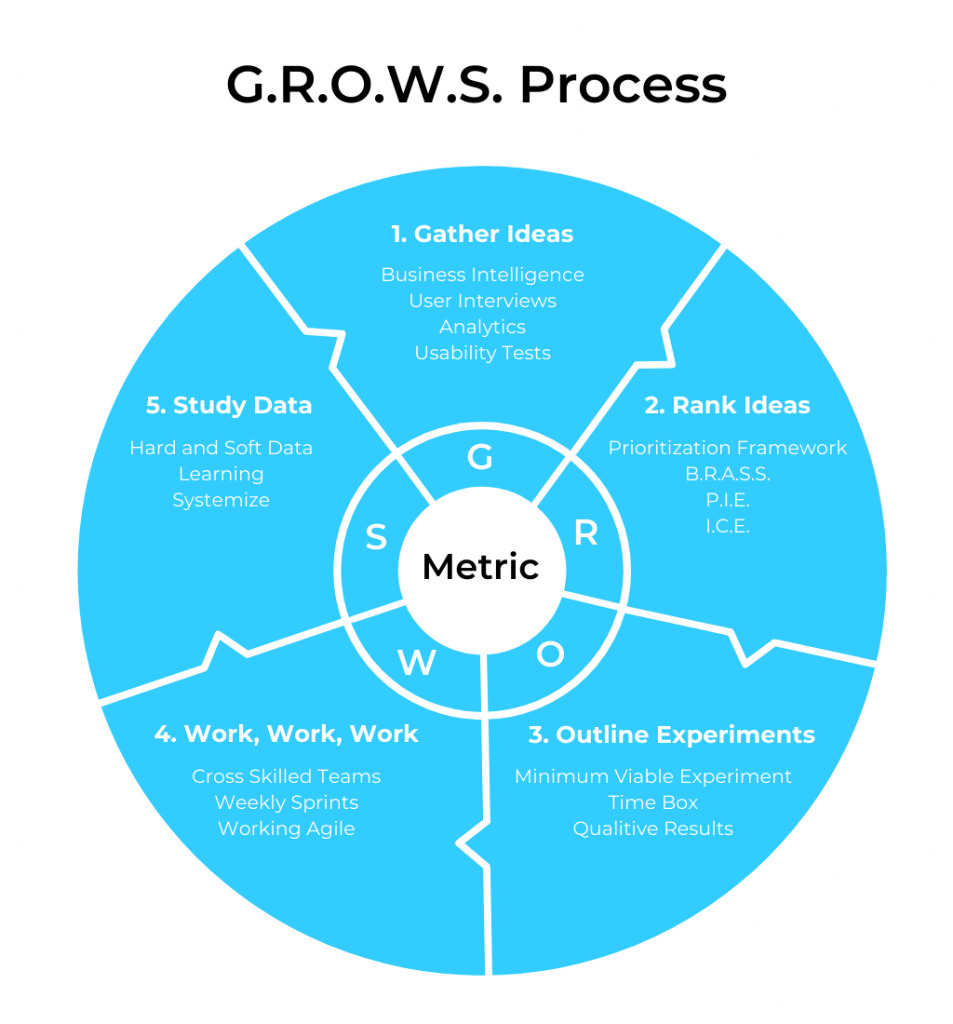
- Gather Ideas
- Rank Ideas
- Outline Experiments
- Work fervently
- Scrutinize Data
Let’s peer deeper into each step:
1. Gather Ideas: Leveraging the data derived from the Pirate Funnel, a clearer picture of the business growth obstacles emerges. We aim for the ‘One Metric That Matters’ or ‘OMTM’, which becomes the focal point for our first G.R.O.W.S. cycle. We invite ideas from all departments, creating a rich ‘backlog’ of proposals available for future experiments. Market competition analysis, customer feedback and software-assisted behavioral analysis help shape these ideas.

2. Rank Ideas: With growth marketing as a long-term plan often operating on a budget, the idea list needs to be sorted from best onwards. We use the B.R.A.S.S. and P.I.E. or I.C.E. frameworks to help rank the ideas.
3. Outline Experiments: This phase involves mapping out each experiment, thinking about its timeframe, necessary resources, and who should be involved. The ideal experiment is one that can be implemented quickly without overstretching resources or needing extensive approval.
4. Work, Work, Work: Now it’s time to roll up sleeves and get to work. We embrace ‘sprints’, a popular growth hacking method that uses short, incremental cycles to test ideas, keeping everyone on the team in sync.
5. Study the Data: The final step involves close examination of the collected data from your experiment. Tools that visually represent information, like graphs and charts, are useful here. If the data supports a successful outcome, we celebrate. If not, we loop back to the first step and restart the process.
That’s the essence of our framework, making growth marketing at Dashly an ongoing venture, continuously evolving based on learnings from user behavior, data, and market feedback.
Thanks! Insights and updates are on their way 💌

Growth marketing experiments for every stage of the funnel
The AARRR model, famously referred to as the Pirate Funnel or Pirate Metrics, ranks amongst the most preferred growth marketing frameworks out there. It organizes and tracks metrics across various user journey stages:
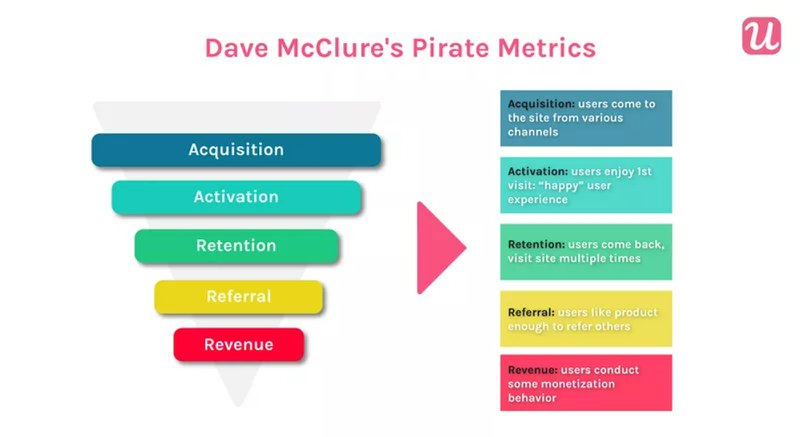
Dave McClure’s Pirate Metrics.
- Acquisition
- Activation
- Retention
- Referral
- Revenue
For product-focused SaaS businesses like ours at Dashly, we often imbue an extra layer to this framework, resulting in the AAARRR model, adding ‘Adoption’ amongst the stages.
Below, we delve into suitable growth marketing strategies for each growth marketing funnel stage, tailored for a SaaS business.
For acquisition in SaaS
The acquisition phase is all about identifying the right leads and metamorphosing them into customers. It serves a dual purpose: driving awareness and actuating that awareness towards decisive action (purchase). It’s that moment when a user chooses to interact with your company, maybe by opting for a product demo or a free trial.
Your growth marketing army should home in on crafting robust customer acquisition channels. Experienced avenues might include:
- Display Paid Advertising: Harness images, gifs, videos, and compelling ad copies on third-party websites relevant to your target audience for wider reach.
- Social Media Marketing (SMM): Tap into social platforms like Twitter, Facebook, Instagram, and others for product promotion and direct customer engagement.
- Search Engine Marketing (SEM): Boost visibility through paid ads garnishing the top spots of search engine results.
- Content Marketing: Churn out valuable articles, videos, etc., to attract, engage, and retain a loyal audience.
- Affiliate Marketing: Rally ‘affiliates’ or partners to champion your product and earn a commission for each sale made via their unique referral links.
- Email Marketing: Maintain a connection with your customers by sharing updates, offers, and new product info.
Moreover, crafting growth loops could bolster company’s growth. Here, users’ actions feed subsequent growth as their results become the input for the next growth cycle. This continuous loop forms an integral cornerstone of our growth marketing strategy at Dashly.
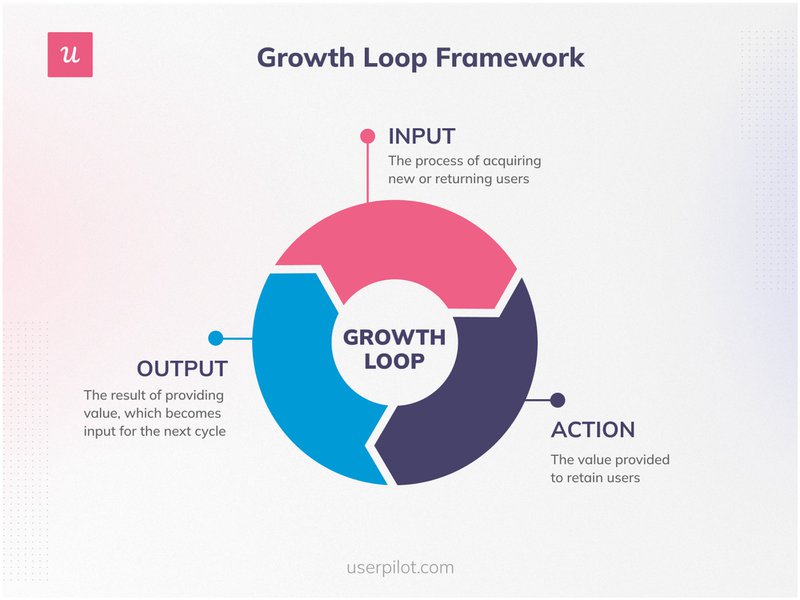
For the activation stage
Once the initial customer acquisition phase is achieved, the activation stage takes center stage with the objective of facilitating these fresh customers to encounter value in your product. This calls for the implementation of a minimum viable onboarding strategy.
Minimum viable onboarding refers to the essential first steps of onboarding aimed at guiding users towards the activation phase. During this period, growth marketing experiments can be executed with varying onboarding tactics tailored to your product to discover what clicks.
For instance, checklists can be employed to nudge users forward. In-app messaging can serve as a tool to help them unlock value, while comprehensive step-by-step guides can illustrate how features function, and providing support options can assist in problem-solving.
The crux here is discovering the perfect blend of onboarding flows that directs users towards grasping the core value of your product, leading them to the activation mark. It’s crucial to note that a significant proportion of first-time product users often switch to becoming paying customers only post-activation. It’s in this stage where growth marketing makes a profound difference in a business’s customer conversion rate.
Find more client onboarding strategies in out post: “How to engage, retain, and win users”
For the retention stage
Even after the initial conversion, the reality is that a customer may contemplate parting ways with your product. This can be a considerable hurdle for SaaS companies like us at Dashly, where recurrent subscriptions hold substantial revenue growth.
When we arrive at the retention stage of our growth marketing framework, the objective is clear: shield against customer attrition and ensure they continue to employ your product and subscribe to your service.
- To bolster retention and slim down the churn rate, focus must be channeled into pursuits that spark user engagement. Regular data gathering through in-app surveys and promptly addressing the feedback can enhance the customer experience and stave off any frustrations.
- Our growth squads can also adopt a foresight approach towards churn mitigation. For example, isolating users showing waning engagement and actively reaching out can steer them back towards re-engagement.
- The end game here is to successfully reel back those customers on the brink of churning by recognizing and mending the roots of their dissatisfaction before they choose to sever ties. It’s an essential stratagem in growth marketing that paves the way towards a successful and scalable business.
Thanks! Here’s your copy of the growth strategy template

For the referral stage
While the best products naturally attract customers, they sometimes need a nudging-hand. In the referral stage of our growth marketing framework at Dashly, the focus is to stimulate growth through customer referrals.
But to coax customers into advocating for your product, they need to be deeply satisfied with it. Hence, the referral stage zeroes in on gauging customer satisfaction to anticipate their likelihood of suggesting your product to others.
There are handy tools like NPS, CES, and CSAT Surveys to assist in this task. For instance, the Net Promoter Score (NPS) straightforwardly inquires about customers’ likelihood of recommending your business to others.
Digging deeper through follow-up questions can shed light on the challenges encountered by your ‘detractors’.
Meanwhile, the Customer Effort Score (CES) serves as a metric indicating the effort exerted by a customer to interact with your business. Both surveys can unveil friction points with your product to scrutinize.
As you gather data about your customers’ challenges, it becomes the trigger to eliminate those obstacles and aim for improved scores. It’s through this circle of learning, improving, and monitoring in our growth marketing approach that high-grade customer satisfaction is achieved.
For the expansion stage
- Cross-Selling: Offer related products or services that complement what a customer already purchased.
- Up-Selling: Encourage customers to buy a more expensive version of the product already in their basket.
- Bundling: Package together multiple products or services at a discounted rate to increase order value.
- Loyalty Programs: Reward repeat customers with incentives, fostering increased buying frequency.
- Referral Programs: Encourage customers to refer friends or colleagues in return for rewards or discounts.
- Product Upgrades: Regularly release new product versions or added features, prompting customers to upgrade.
- Educational Content: Provide resources that make customers more skilled at using your product or service.
How Dashly can boost your business growth
Dashly is a code-free growth marketing platform that provides all the instruments to collect data about customer behavior and interests to personalize communication with them and boost business growth. It helps you:
Get more leads from your current traffic
- Create targeted business messaging campaigns with pop-ups, chatbot and emails.
- Engage your customers into a conversation and collect leads.
- Hand those who are ready to buy to your Sales Team.
- Automatically reply to customer FAQs.
- Keep lead collection going 24/7.


Supply your Sales Team with high-quality leads only
- Use a chatbot to free your team from answering the same questions over and over again.
- Prioritize hot leads and hand those who are ready to buy to the Sales Team.
- Use rich customer data to create personalized offers and close more deals.
Keep all the info on your customers and design messaging campaigns that convert
- Track of your website visitors’ behavior: where they come from, what pages they viewed, what CTAs they clicked.
- Use this data to launch marketing strategies at the right moment with the right offer.
- Nurture, activate, retain and return visitors with pop-ups, chatbots and emails.
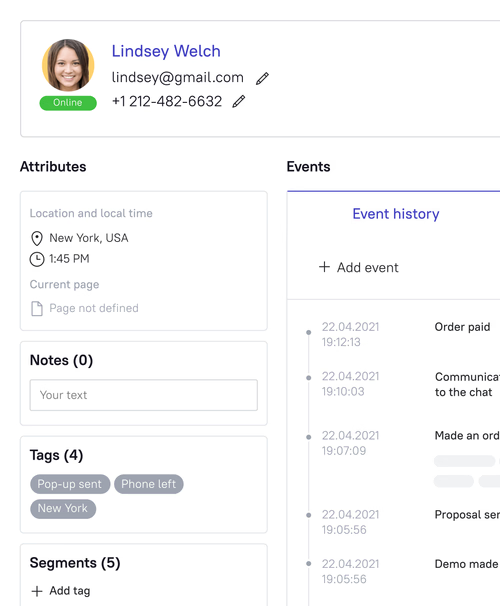
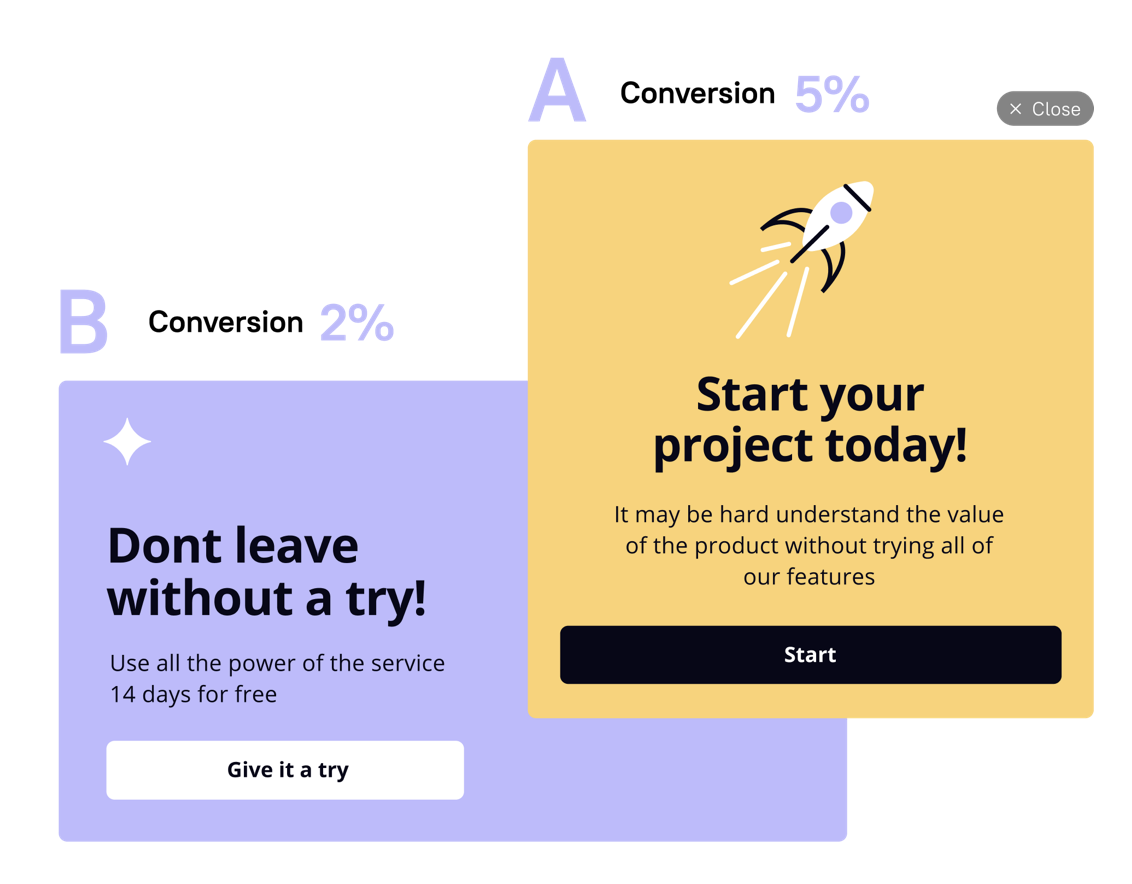
Launch A/B tests and analyze the results without developers
Build your framework based on the data-driven decisions. Launch marketing campaigns that convert and analyze the performance of growth marketing initiative.
FAQ
How many growth marketing frameworks exist?
Numerous growth marketing frameworks exist, designed to suit various business needs and marketing goals. These frameworks assist marketing teams in manageably handling their growth objectives, focusing on different stages of the customer lifecycle, from acquisition to referral. Examples include AARRR (Pirate Metrics), Bullseye Framework, Growth Hacking Funnel, G.R.O.W.S. Process, and many more.
What is the difference between growth marketing and traditional marketing frameworks?
Growth marketing diverges from traditional marketing in that it leverages data-driven experiments throughout the entire customer lifecycle to optimize performance. Traditional marketing strategies often focus on acquiring new customers and brand awareness, while growth marketing nurtures customer relationships to maximize retention, revenue, and referrals, along with acquisition.
How to build growth marketing strategies?
To build growth marketing strategies, marketers must first understand their customer deeply. Then, follow a systematic process, usually a growth marketing framework characterized by iteration: set a goal (choose a key metric to focus on), gather and prioritize ideas based on data and creativity, test these ideas swiftly, and then measure the results. Continue this loop, making data-informed decisions and adjustments along the way.
What is a product market growth framework?
A product market growth framework, often referred to as the Ansoff Matrix, is a strategic tool that helps companies decide their product and market growth strategy. It explores growth opportunities through existing or new products, in existing or new markets. This framework is especially useful in growth marketing for understanding potential risks associated with various growth paths for a product or a service and its customer base.
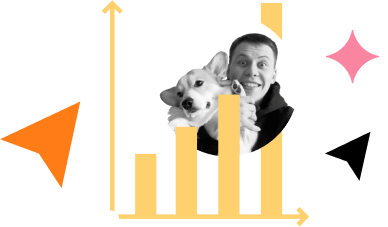



![The ultimate guide to growth marketing in 2025 [explained by a growth hacker]](https://www.dashly.io/blog/wp-content/uploads/2023/04/The-ultimate-guide-to-growth-marketing-explained-by-a-growth-hacker-720x317.png)
![Ultimate guide to creating a successful marketing growth strategy in 2025 [6 real-life examples]](https://www.dashly.io/blog/wp-content/uploads/2023/05/Expert-guide-to-creating-marketing-growth-strategy-6-examples-720x317.png)